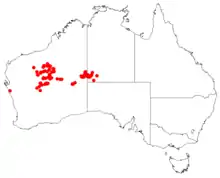| Walukara | |
|---|---|
 | |
| Hakea rhombales in Kings Park | |
| Scientific classification | |
| Kingdom: | Plantae |
| Clade: | Tracheophytes |
| Clade: | Angiosperms |
| Clade: | Eudicots |
| Order: | Proteales |
| Family: | Proteaceae |
| Genus: | Hakea |
| Species: | H. rhombales |
| Binomial name | |
| Hakea rhombales | |
 | |
| Occurrence data from Australasian Virtual Herbarium | |
Hakea rhombales, commonly known as walukara,[2] is a shrub in the family Proteacea. It has red, pink or purple flowers and is endemic to Western Australia and the Northern Territory.
.jpg.webp)

Description
The bushy shrub typically grows to a height of 1.5 to 3 metres (5 to 10 ft) and is usually just as wide. It blooms from April to September and produces red-pink-purple flowers.
The branchlets and young leaves are appressed-pubescent with ferruginous hairs but otherwise glabrescent. The simple leaves are 6.5 to 23 centimetres (3 to 9 in) long and 1.6 to 1.9 mm (0.06 to 0.07 in) wide.
Inflorescence are erect and sometimes from old wood, they contain 10–16 flowers with simple rachis that are 7 to 11 mm (0.28 to 0.43 in) long. The inflorescence is glabrous or appressed-pubescent with pedicels approximately 6 mm (0.24 in) long.
The fruit are formed in an obliquely obovate shape, 2.2 to 3.5 cm (0.9 to 1.4 in) long and 1.6 to 2.3 cm (0.6 to 0.9 in) wide. The fruit are black-pusticulate with a toothed crest found on either side of suture.[3][4]
Taxonomy and naming
Hakea rhombales was first formally described by the botanist Ferdinand von Mueller in 1876 in Fragmenta Phytographiae Australiae.[5][6] The name of the species is from the Latin word rhombus referring to the shape of the wing on the seed.[4]
Distribution and habitat
Walukara has a scattered distribution through area in the Pilbara and the Goldfields regions of Western Australia where it is found on sand dunes, plains and hillsides growing in sandy or loamy soils.[3] Its range extends east into the Northern Territory to around the Petermann Range.[4][7]
Conservation status
Hakea rhombales is classified as "not threatened" by the Western Australian Government Department of Parks and Wildlife.[3]
References
- ↑ "Hakea rhombales". Australian Plant Census. Retrieved 19 September 2019.
- ↑ "King Park in June". Image Event. Retrieved 21 June 2016.
- 1 2 3 "Hakea rhombales". FloraBase. Western Australian Government Department of Biodiversity, Conservation and Attractions.
- 1 2 3 "Hakea rhombales factsheet". Government of South Australia. Retrieved 21 June 2016.
- ↑ "Hakea rhombales". APNI. Retrieved 28 October 2019.
- ↑ "Fragmenta Phytographiae Australiae". Biodiversity Heritage Library. Retrieved 19 September 2019.
- ↑ "Hakea rhombales". Flora NT. Northern Territory Government. Retrieved 19 September 2019.